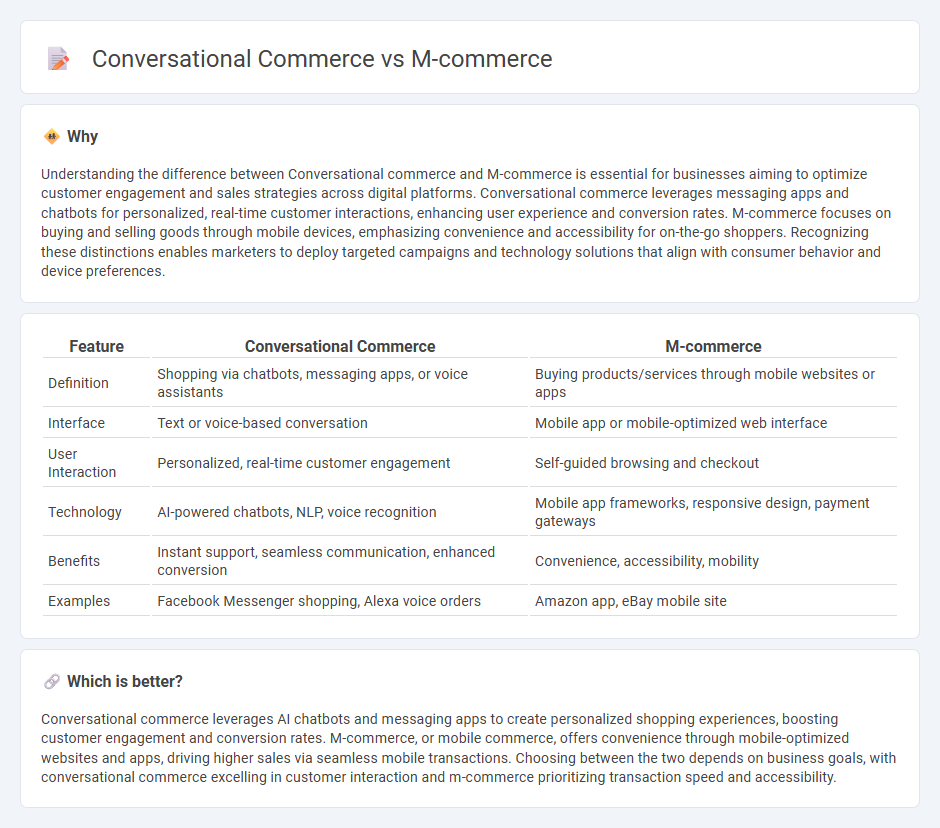
Conversational commerce leverages messaging apps and chatbots to facilitate personalized customer interactions, streamlining the buying process through real-time conversations. M-commerce focuses on mobile device transactions, enabling users to shop anytime and anywhere via optimized apps and mobile websites. Explore the differences and benefits of conversational commerce and m-commerce to enhance your digital sales strategy.
Why it is important
Understanding the difference between Conversational commerce and M-commerce is essential for businesses aiming to optimize customer engagement and sales strategies across digital platforms. Conversational commerce leverages messaging apps and chatbots for personalized, real-time customer interactions, enhancing user experience and conversion rates. M-commerce focuses on buying and selling goods through mobile devices, emphasizing convenience and accessibility for on-the-go shoppers. Recognizing these distinctions enables marketers to deploy targeted campaigns and technology solutions that align with consumer behavior and device preferences.
Comparison Table
| Feature | Conversational Commerce | M-commerce |
|---|---|---|
| Definition | Shopping via chatbots, messaging apps, or voice assistants | Buying products/services through mobile websites or apps |
| Interface | Text or voice-based conversation | Mobile app or mobile-optimized web interface |
| User Interaction | Personalized, real-time customer engagement | Self-guided browsing and checkout |
| Technology | AI-powered chatbots, NLP, voice recognition | Mobile app frameworks, responsive design, payment gateways |
| Benefits | Instant support, seamless communication, enhanced conversion | Convenience, accessibility, mobility |
| Examples | Facebook Messenger shopping, Alexa voice orders | Amazon app, eBay mobile site |
Which is better?
Conversational commerce leverages AI chatbots and messaging apps to create personalized shopping experiences, boosting customer engagement and conversion rates. M-commerce, or mobile commerce, offers convenience through mobile-optimized websites and apps, driving higher sales via seamless mobile transactions. Choosing between the two depends on business goals, with conversational commerce excelling in customer interaction and m-commerce prioritizing transaction speed and accessibility.
Connection
Conversational commerce integrates chatbots and messaging apps to create personalized shopping experiences, driving mobile commerce (m-commerce) growth by enabling users to make purchases directly through mobile devices. The seamless interaction between conversational interfaces and mobile platforms enhances customer engagement, convenience, and real-time support, which increases conversion rates in m-commerce. Businesses leveraging AI-powered conversational agents on mobile apps optimize user journeys, leading to higher sales and improved customer retention.
Key Terms
Mobile Applications
M-commerce leverages mobile applications to facilitate direct purchases, offering seamless checkout experiences and personalized product recommendations through app interfaces. Conversational commerce integrates chatbots and voice assistants within mobile apps, enabling users to interact via natural language for customer support, product discovery, and transactions. Explore how these mobile application strategies transform digital retail by driving engagement and boosting sales.
Chatbots
M-commerce leverages mobile devices to facilitate seamless online purchases through apps and mobile-optimized websites, enhancing user convenience and accessibility. Conversational commerce utilizes chatbots powered by AI to engage customers in real-time conversations, providing personalized recommendations and streamlined shopping experiences. Discover how integrating chatbots can transform your commerce strategy and boost customer satisfaction.
User Experience
M-commerce enhances user experience by offering seamless mobile shopping with intuitive interfaces, fast load times, and personalized recommendations based on user behavior. Conversational commerce improves engagement through real-time interactions using chatbots and voice assistants, facilitating instant support and tailored product suggestions. Explore deeper insights into optimizing user experience across these commerce platforms.
Source and External Links
What is m-commerce vs. e-commerce? - Adjust - M-commerce, short for mobile commerce, is a subset of e-commerce that specifically refers to commercial transactions done via mobile apps or mobile websites.
M-Commerce: Applications, Advantages & Disadvantages - Carmatec - M-commerce involves buying and selling goods and services through mobile devices like smartphones and tablets, covering applications such as retail shopping, mobile banking, travel booking, entertainment, and mobile payments.
m-commerce (mobile commerce) - TechTarget - M-commerce is the buying and selling of goods and services through wireless handheld devices, enabling in-app purchases, mobile banking, and use of digital wallets, serving as a form of e-commerce optimized for mobile usage.
 dowidth.com
dowidth.com